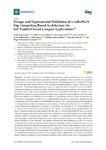Mostrar o rexistro simple do ítem
Design and Experimental Validation of a LoRaWAN Fog Computing Based Architecture for IoT Enabled Smart Campus Applications
| dc.contributor.author | Fraga-Lamas, Paula | |
| dc.contributor.author | Celaya-Echarri, Mikel | |
| dc.contributor.author | López Iturri, Peio | |
| dc.contributor.author | Castedo, Luis | |
| dc.contributor.author | Azpilicueta, Leyre | |
| dc.contributor.author | Aguirre, Erik | |
| dc.contributor.author | Suárez-Albela, Manuel | |
| dc.contributor.author | Falcone, Francisco | |
| dc.contributor.author | Fernández-Caramés, Tiago M. | |
| dc.date.accessioned | 2019-08-26T09:18:26Z | |
| dc.date.available | 2019-08-26T09:18:26Z | |
| dc.date.issued | 2019-07-26 | |
| dc.identifier.citation | FRAGA-LAMAS, Paula, et al. Design and Experimental Validation of a LoRaWAN Fog Computing Based Architecture for IoT Enabled Smart Campus Applications. Sensors, 2019, vol. 19, no 15, p. 3287. | es_ES |
| dc.identifier.issn | 1424-8220 | |
| dc.identifier.uri | http://hdl.handle.net/2183/23860 | |
| dc.description.abstract | [Abstract] A smart campus is an intelligent infrastructure where smart sensors and actuators collaborate to collect information and interact with the machines, tools, and users of a university campus. As in a smart city, a smart campus represents a challenging scenario for Internet of Things (IoT) networks, especially in terms of cost, coverage, availability, latency, power consumption, and scalability. The technologies employed so far to cope with such a scenario are not yet able to manage simultaneously all the previously mentioned demanding requirements. Nevertheless, recent paradigms such as fog computing, which extends cloud computing to the edge of a network, make possible low-latency and location-aware IoT applications. Moreover, technologies such as Low-Power Wide-Area Networks (LPWANs) have emerged as a promising solution to provide low-cost and low-power consumption connectivity to nodes spread throughout a wide area. Specifically, the Long-Range Wide-Area Network (LoRaWAN) standard is one of the most recent developments, receiving attention both from industry and academia. In this article, the use of a LoRaWAN fog computing-based architecture is proposed for providing connectivity to IoT nodes deployed in a campus of the University of A Coruña (UDC), Spain. To validate the proposed system, the smart campus has been recreated realistically through an in-house developed 3D Ray-Launching radio-planning simulator that is able to take into consideration even small details, such as traffic lights, vehicles, people, buildings, urban furniture, or vegetation. The developed tool can provide accurate radio propagation estimations within the smart campus scenario in terms of coverage, capacity, and energy efficiency of the network. The results obtained with the planning simulator can then be compared with empirical measurements to assess the operating conditions and the system accuracy. Specifically, this article presents experiments that show the accurate results obtained by the planning simulator in the largest scenario ever built for it (a campus that covers an area of 26,000 m 2 ), which are corroborated with empirical measurements. Then, how the tool can be used to design the deployment of LoRaWAN infrastructure for three smart campus outdoor applications is explained: a mobility pattern detection system, a smart irrigation solution, and a smart traffic-monitoring deployment. Consequently, the presented results provide guidelines to smart campus designers and developers, and for easing LoRaWAN network deployment and research in other smart campuses and large environments such as smart cities. | es_ES |
| dc.description.sponsorship | Xunta de Galicia; ED431C 2016-045 | es_ES |
| dc.description.sponsorship | Xunta de Galicia; ED431G/01 | es_ES |
| dc.description.sponsorship | Agencia Estatal de Investigación de España; TEC2016-75067-C4-1-R | es_ES |
| dc.language.iso | eng | es_ES |
| dc.publisher | MDPI AG | es_ES |
| dc.relation.uri | https://doi.org/10.3390/s19153287 | es_ES |
| dc.rights | Atribución 4.0 España | es_ES |
| dc.rights.uri | http://creativecommons.org/licenses/by/4.0/es/ | * |
| dc.subject | IoT | es_ES |
| dc.subject | Smart campus | es_ES |
| dc.subject | Sustainability | es_ES |
| dc.subject | Fog computing | es_ES |
| dc.subject | Outdoor applications | es_ES |
| dc.subject | lPWAN | es_ES |
| dc.subject | LoRaWAN | es_ES |
| dc.subject | 3D ray launching | es_ES |
| dc.subject | Smart cities | es_ES |
| dc.subject | Wireless Sensor Networks (WSN) | es_ES |
| dc.title | Design and Experimental Validation of a LoRaWAN Fog Computing Based Architecture for IoT Enabled Smart Campus Applications | es_ES |
| dc.type | info:eu-repo/semantics/article | es_ES |
| dc.rights.access | info:eu-repo/semantics/openAccess | es_ES |
| UDC.journalTitle | Sensors | es_ES |
| UDC.volume | 19 | es_ES |
| UDC.issue | 15 | es_ES |
| UDC.startPage | 3287 | es_ES |
| dc.identifier.doi | 10.3390/s19153287 |
Ficheiros no ítem
Este ítem aparece na(s) seguinte(s) colección(s)
-
GI-GTEC - Artigos [190]






